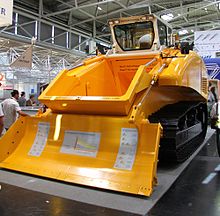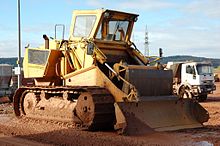Scraper
A scraper or scraper is a versatile construction machine that can be used to remove, transport, and unload or reinstall the soil at another location. It belongs to the group of dozers and provides simplified terms, a combination of the caterpillar tracks of a bulldozer and the raised and lowered draglines a motor scraper car represents.
Scrapers are listed in the BGL / EUROLISTE under the code number D.5.10 - Scraper .
history
In the pre-war years, the Wehrmacht was looking for a powerful, compact and universal pioneer device that could also cope with the soil and weather conditions prevailing in Europe. The Hamburg construction machinery manufacturer Menck & Hambrock was then commissioned to develop and manufacture such a pioneering device. By 1939, the company had been supplying eight scrapers with the type designation SR39 based on the designs by Hugo Cordes . They had a bucket volume of 5 cubic meters and an output of 100 to 115 hp, which was generated by a Kaelble diesel engine. Since the factory was already busy with the production of further armaments, it was not possible to achieve a higher number of pieces with this type. In 1943 Menck & Hambrock further developed the SR39 into the SR43 . The steel construction company Benteler then produced 30 machines with a 120 hp engine (hence the name Benteler-Menck scraper ).
After the Second World War, Hugo Cordes and Günter Kühn continued the development and production of scrapers at Menck and Hambrock. Starting in 1953, 24 SR53 machines with 6.5 cubic meters of bucket volume and 175 HP were produced annually , which were then used worldwide. The Hamburg company later developed even more powerful machines, such as the types SR65 with 6.5 cubic meters of bucket volume and 200 hp and SR85 with 8.5 cubic meters of bucket volume and 220 hp. In total, around 350 scrapers had been built in Hamburg before Menck & Hambrock went bankrupt.
On the basis of a license agreement, the manufacture of scrapers also began in Japan in the post-war period. First machines of the type SR62 and somewhat smaller machines of the type SR40 with 4 cubic meters of bucket volume were manufactured there. There were also further developments, such as the SR264 without powershift transmission and converter. Later, the need for larger scrapers increased and the Japanese company Nippon Sharyo developed the SR2000 with a 10 cubic meter bucket volume and 315 hp. Around 3000 pieces of this scraper were manufactured together with the successor model SR2001 until production was discontinued .
After Menck & Hambrock went bankrupt, the Swiss company Bührer improved the previously available SR85 and launched the SR928 and Operator 1030 with 10 cubic meters of bucket volume and 300 hp. The Swiss company Frutiger, on the other hand, initially imported Japanese scrapers for resale in Europe for many years and only later developed new scrapers.
construction
The scraper is an essential part of the scraper. It is located between two crawler tracks in the middle of the machine and can be lowered or raised using two hydraulic cylinders . The front of the bucket has a scraper bar for the scraping process and a hydraulically swiveling flap to close the bucket. At the back is the back wall of the bucket, which can be pushed forward with the help of the hydraulics to empty the bucket.
The diesel engine with converter and powershift transmission, the steering clutch and the chain drive, the hydraulic system and all control and operating elements are located in the rear of the scraper. These components lie in a tub and are thus protected from dirt and water. In front of the bucket there is a dozer blade that can be folded up during the digging process. The driver's cab is located above the bucket and engine. The driver's seat located there is installed transversely to the direction of travel, so that the operator has a clear view of the recurring forward and reverse travel and can work as fatigue-free as possible.
Working method
The scraper carries out the following work steps in normal operation:
- In the first step, the bucket is lowered to the desired digging depth while driving forwards in 1st or 2nd gear (maximum possible is almost 50 cm) and in this way the soil is loosened and loaded at the same time. After about 20 to 30 seconds and a digging distance of 20 to 40 meters, the bucket is completely full. Then the front flap is closed and the bucket specified.
- The excavated material is then transported to the unloading point in the raised bucket at a speed of around 15 to 20 km / h.
- The next step is to install the material at the unloading point. It is possible to push the material out of the bucket while driving and thus apply it over a large area. Another possibility is to empty the bucket while standing on the dump or on the edge of a slope.
- Finally, the scraper reverses back to the digging point at a speed of 15 to 20 km / h and the process begins again. Because of the alternating forward and reverse travel, this sequence is also known as shuttle traffic. If the scraper is equipped with fangs, the ground can still be torn up when reversing.
commitment
With the help of the scraper, soil with a soft to firm consistency can be loosened, loaded, transported and then filled up or reinstalled. The dozer blade or additional ripper teeth expand the range of applications. In contrast to earthworks with vehicles with pneumatic tires, this also works on particularly soft ground thanks to the crawler chassis. In addition, the scraper can be used at a water depth of 1 meter (with special equipment even 1.8 meters are possible) without being damaged. With a travel speed of 15 to 20 km / h (with a load, forwards and backwards on level ground), 100 meters of conveying distance and a bucket volume of 10 cubic meters, an installation capacity of up to 200 cubic meters per hour or almost 2000 cubic meters per day can be achieved. Transport distances of 50 meters to 500 meters are considered economical for the scraper.
Despite their productivity and long history, scrapers are not very common and even unknown to many involved in construction. However, there are also legitimate points of criticism about the use of scrapers. The operation of this heavy and fast machine places high demands on the machinist and it takes a lot of time for him to fully master the machine. In addition, he is often left to his own devices, as there are usually no other machines in use on the construction site. The high acquisition and maintenance costs (higher chain wear and fuel consumption) are also criticized. It must be noted, however, that the construction and equipment of the scraper can cope with many earthworks tasks for which several construction machines are otherwise required or have to work together. For example, an earthmoving company with a hydraulic excavator, two to four trucks and a bulldozer can be replaced by a scraper and thus save money.
Manufacturer

The only remaining manufacturer for scrapers is currently (as of December 2019) the Frutiger company from Winterthur in Switzerland. Your first in-house development was the SR3000 Tiger with a 15 cubic meter bucket volume and 480 hp. In 2007 Frutiger brought the successor model SR T-18 Tiger onto the market. This largest scraper ever built has a bucket volume of 18 m³, is 7.2 m long, 3.50 m wide, 3.4 m high and weighs around 38 t (empty weight). Your bucket has a scraping width of 1.92 m and the output is between 200 m³ / h to 450 m³ / h, depending on the model used, at a transport distance of about 100 m.
See also
literature
- Günter Kühn: Mechanical earthworks . Springer-Verlag, 2013, ISBN 978-3-663-08094-7 , page 186 ff.
- Max Scholz: Yearbook Construction Machines 2019. Podszun-Verlag, 2018, ISBN 978-3-86133-894-9 , page 105 ff.
Web links
- Further information on the history and operation of the scraper with many pictures ( Memento from February 2, 2001 in the Internet Archive )
Individual evidence
- ↑ Main Association of the German Construction Industry: BGL Construction Equipment List 2015 . Bauverlag, 2015, ISBN 978-3-7625-3670-3 .
- ↑ Technical data SR T-18 Tiger , accessed on December 28, 2019.



